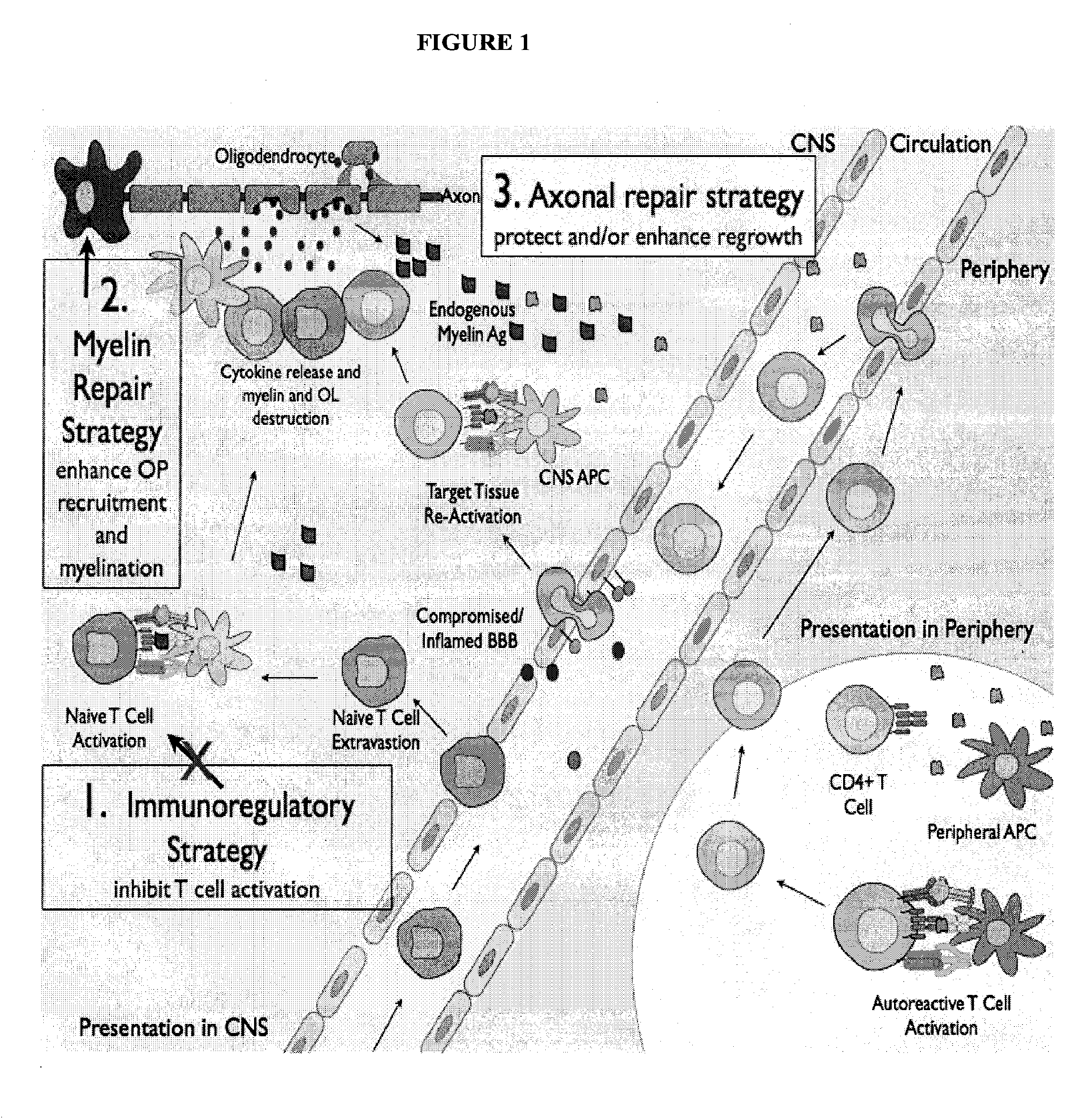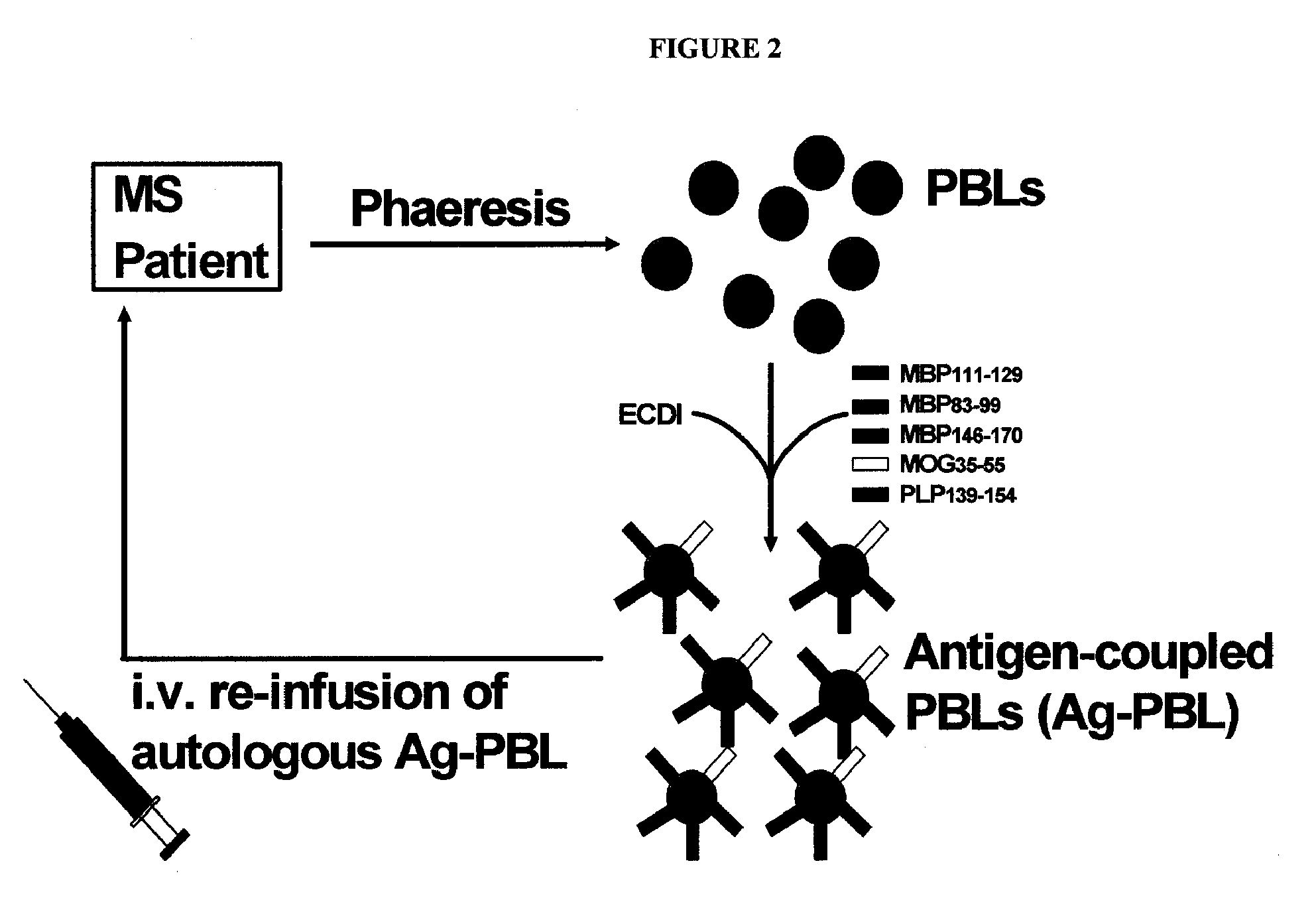Multiple sclerosis therapy
a multi-sclerosis and therapy technology, applied in the field of multi-sclerosis therapy, can solve the problems of severe damage or injury to myelin, affecting the conduction velocity, and the vulnerability of neurons to axonal destruction, and affecting the recovery of animals, so as to promote myelin repair, remyelination and/or axonal maintenance, protection or regeneration
- Summary
- Abstract
- Description
- Claims
- Application Information
AI Technical Summary
Benefits of technology
Problems solved by technology
Method used
Image
Examples
example 1
[0195]The γ-secretase inhibitor LY411575 was administered in a cell-culture assay and illustrated that while there was no observed effect on T cell proliferation, the amount of T cell differentiation of the inflammatory Th1 subset of CD4+ T cells was decreased. When LY411575 was injected into EAE animals, the severity of EAE was decreased.
[0196]Candidate agents are screened with LY411575 in vitro, to identify agents that confers a synergistic effect of promoting myelination when compared to the candidate agent or LY411575 alone. Agents conferring synergistic effects are identified by increased oligodendrocyte proliferation, migration, or differentiation as compared to control cells.
[0197]Agents identified from in vitro assays are used in animal models. Relasping EAE (R-EAE), chronic EAE (C-EAE) or TMEV-IDD is induced in the appropriate mouse strains. Following onset of acute disease, the mice are separated equally by clinical disease scores into four groups: (1) mice ...
example 2
Immunolopical Assays
[0198]Clinical disease scores are recorded daily to determine effects on clinical disease progression and relapse rate. CD4+ T cell responses are analyzed upon recall with the specific peptide used for priming. Delayed-type hypersensitivity (DTH) experiments are performed to determine antigen-specific CD4 Th1 activation and migration in vivo. In vitro recall experiments such as proliferation assays and ELISPOTS are performed to measure numbers of cytokine producing T cells. Cytokine LiquiChip analysis is performed to measure amount of cytokine production. Spleens and lymph nodes are isolated from treated and untreated mice to analyze immune responses upon re-challenge with myelin peptides.
[0199]Lower clinical scores may be expected in the combinatorial treatment group. Amelioration of clinical disease may result in a lower Th1 cytokine expression (i.e., IFN-γ, TNF-α, IL-2) and higher Th2 expression (i.e., IL-4, IL-5, IL-10, TGF-β). Flow cytometry (FACS) and immun...
example 3
Neurobiological Experiments
[0200]PLP staining is combined with staining for CD4+ T cells and CD11b+ macrophages to identify myelin and extent of infiltration following the various treatments. Additionally, CNPase and CC1, markers of oligodendrocyte lineage cells, are used in immunohistochemical analyses to detect differences in oligodendrocyte numbers between treated and control mice. In addition to oligodendrocyte differentiation, which is only one component of successful myelin repair, toluidine blue and / or luxol fast blue staining procedures are used to detect the extent of remyelination in fixed sections of brain and spinal cord. Where combinatorial treatment enhances remyelination (as assessed by toluidine or luxol fast blue), correlation with increased myelin gene expression is determined by real-time PCR and microarray analysis).
PUM
| Property | Measurement | Unit |
|---|---|---|
| time | aaaaa | aaaaa |
| time | aaaaa | aaaaa |
| time | aaaaa | aaaaa |
Abstract
Description
Claims
Application Information
 Login to View More
Login to View More - R&D
- Intellectual Property
- Life Sciences
- Materials
- Tech Scout
- Unparalleled Data Quality
- Higher Quality Content
- 60% Fewer Hallucinations
Browse by: Latest US Patents, China's latest patents, Technical Efficacy Thesaurus, Application Domain, Technology Topic, Popular Technical Reports.
© 2025 PatSnap. All rights reserved.Legal|Privacy policy|Modern Slavery Act Transparency Statement|Sitemap|About US| Contact US: help@patsnap.com



